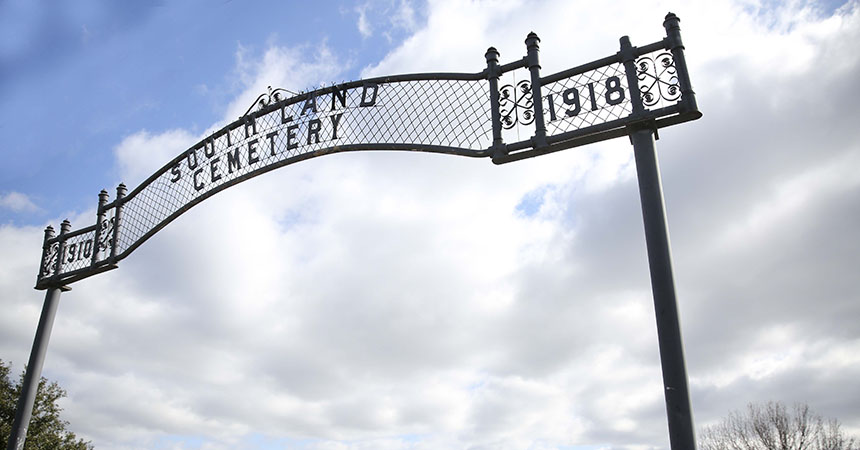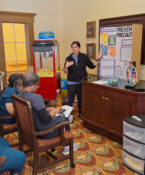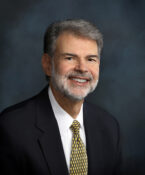NamUs victims unit helps bring closure to a family with a missing loved one
By Diane Smith
Clark Edward Wilson was case number 16-20100 until one chilly February morning.
Wilson died in 2016 of heart disease and emphysema. At that time, he was an unidentified person so Dallas County buried him at Southland Memorial Park Cemetery in Grand Prairie. His marker was placed near the burial sites of other unidentified people who are known only by their medical examiner case numbers.
Wilson was among the thousands of unidentified persons whose bodies are recovered every year nationwide. But thanks to the Center for Human Identification at The University of North Texas Health Science Center at Fort Worth, Wilson’s remains were returned to his family.
“When the identification was made, law enforcement reached out to notify the next of kin, which happened to be this gentleman’s twin sister in Virginia,” said Tiffany Mow, director of the National Missing and Unidentified Persons System (NamUs) Victim Services Division. “She indicated that she would like to bring her brother home.”
The disinterment of Wilson’s remains was the first exhumation handled by the Victims Services Division, which was created to help families impacted by missing loved ones.
NamUs, is a national information clearinghouse and resource center for missing, unidentified and unclaimed people. It is managed within the Center for Human Identification through a cooperative agreement with the National Institute of Justice.
“We offer every resource and service that is needed to resolve a missing, unidentified or unclaimed person case,” said B.J. Spamer, Executive Director of NamUs Operations. “Now, after the case is resolved, through the Victims Services Division, we have additional resources to support those families.”
Spamer said the services don’t cost families anything.
Honoring a family’s wishes
Wilson was unidentified for years, but last August, a fingerprint match by the Texas Department of Public Safety helped unravel his case.
The Wilson case was the second reunification case for the Victim Services Division, which includes two program coordinators who work with families. In December, the division helped a family whose loved one’s body was found in Colorado and returned to Pharr, Texas.
“This is something we can do for families based on their wishes,” Mow said.
The Wilson exhumation involved paperwork signed by the Dallas County Medical Examiner Office.
The Medical Examiner is legally responsible for the burial of unidentified deceased individuals and the identification of them, said Casey A. Gould, deputy chief medicolegal death investigator with the Dallas County Medical Examiner Office.
When an unidentified person is buried, the county collects “a long list of data as prescribed by law,” Gould said, adding that unidentified bodies are buried in concrete vaults with two metal tags indicating their case number on a body bag.
These graves are marked with footstones identified by case numbers.
“When we have a case like this, we must personally ensure we have the right person released to the funeral home,” Gould said.
Finding closure
Identifications are supported by NamUs through various free forensic services, including fingerprint, dental and DNA analyses provided by the Center for Human Identification laboratories.
Eric Gonzalez, program coordinator, said the Victims Services Division began working on the Wilson case in September when they were contacted by a NamUs regional program specialist about the fingerprint match.
Gonzalez said Wilson’s family wanted his body cremated. So he worked with the cemetery and a funeral home to pay for sending Wilson’s ashes to Virginia.
Gonzalez said family members told him they didn’t know what happened to Wilson.
“His twin sister told me, ‘We always wondered what happened to him. We never got closure,’” he said.
Wilson’s niece, Cindy Hackman, said her mother, Helen Steen, and Wilson grew up in Bedford, Va. The twins, who were among six siblings, spent time in foster homes after the death of their mother.
Hackman’s mother last saw her twin brother when she got married in 1963. They were 17.
“I was told he was a fun-loving youth who loved his family,” Hackman said, adding that one family member apparently talked to him in the 1980s, but there were few details about that conversation.
Hackman said they learned about her uncle’s identification shortly before Aug. 25, when her uncle and mother share a birth date. He would have turned 73.
“I never met him,” said Hackman, who documents the family’s genealogy. “I hope to learn more about his life.”



![Uyen Sa Nguyen Scaled[58]](https://www.unthsc.edu/newsroom/wp-content/uploads/sites/16/Uyen-Sa-Nguyen-scaled58-145x175.jpg)


Social media